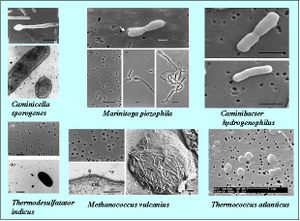User:Blomm013: Difference between revisions
| Line 38: | Line 38: | ||
==References== | ==References== | ||
[1] Alain, K., A. Postec, E. Grinsard, F. Lesongeur, D. Prieur, and A. Godfroy. "Thermodesulfatator Atlanticus Sp. Nov., a Thermophilic, Chemolithoautotrophic, Sulfate-reducing Bacterium Isolated from a Mid-Atlantic Ridge Hydrothermal Vent." International Journal Of Systematic And Evolutionary Microbiology 60.1 (2010): 33-38. Web. | [1] Alain, K., A. Postec, E. Grinsard, F. Lesongeur, D. Prieur, and A. Godfroy. "Thermodesulfatator Atlanticus Sp. Nov., a Thermophilic, Chemolithoautotrophic, Sulfate-reducing Bacterium Isolated from a Mid-Atlantic Ridge Hydrothermal Vent." International Journal Of Systematic And Evolutionary Microbiology 60.1 (2010): 33-38. Web. http://ijs.sgmjournals.org/content/60/1/33.long | ||
[1] EXAMPLE ONLY. REPLACE WITH YOUR REFERENCES. Takai, K., Sugai, A., Itoh, T., and Horikoshi, K. 2000. "''Palaeococcus ferrophilus'' gen. nov., sp. nov., a barophilic, hyperthermophilic archaeon from a deep-sea hydrothermal vent chimney". ''International Journal of Systematic and Evolutionary Microbiology''. 50: 489-500. http://ijs.sgmjournals.org/cgi/reprint/50/2/489 | [1] EXAMPLE ONLY. REPLACE WITH YOUR REFERENCES. Takai, K., Sugai, A., Itoh, T., and Horikoshi, K. 2000. "''Palaeococcus ferrophilus'' gen. nov., sp. nov., a barophilic, hyperthermophilic archaeon from a deep-sea hydrothermal vent chimney". ''International Journal of Systematic and Evolutionary Microbiology''. 50: 489-500. http://ijs.sgmjournals.org/cgi/reprint/50/2/489 | ||
Revision as of 23:33, 19 July 2013
Classification=
Bacteria; Thermodesulfobacteria; Thermodesulfobacteriales; Thermodesulfobacteriaceae; Thermodesulfatator
Thermodesulfatator atlanticus
Description and Significance
Thermodesulfatator atlanticus is a thermophile that was found in the walls of an active deep-sea hydrothermal vent on the Mid-Atlantic Ridge at Rainbow vent. Thermophiles are species that can grow at high temperatures. It was categorized as a Thermodesulfatator because it shares 97.8 % similarity with the species that is representative of that genus, Thermodesulfatator indicus. Both species are anaerobic, chemolithoautotrophs, thermophiles, and sulfate reducers found in deep-sea hydrothermal vents. The two species do differ in a few key ways, however. T. indicus is strictly a chemolithoautotroph, where as T. atlanticus has the ability to use both inorganic and organic Carbon sources for energy. T. atlanticus is also able to survive in a wider range of pH conditions. [1]
T. atlanticus was placed in the Thermodesulfobacteriacae family because of its' 16S rRNA gene sequences. [1]
Give a brief description of the microorganism and explain why you think it is important. How does it relate to the other organisms in its phylum (bacteria and fungi) or group (archaea, virus, protist). Use the following for each reference in text (change number accordingly)-->
Structure, Metabolism, and Life Cycle
T. atlanticus is a gram-negative rod-shaped bacteria. The cells are found mostly in singular form. It possesses a singular polar flagellum, which gives the cell high motility. The cell divides by constriction. Its genome contains a high GC content of 45.6 mol%, which adds stability to the cell since GC pairs are more stable than AT pairs. This is because they are held together by three hydrogen bonds rather than two. [1]
T. atlanticus is an obligate anaerobe, meaning it cannot survive in the presence of oxygen. It generally uses CO2 as a Carbon source, but monomethylamine, peptone, and yeast extract can also be used for this purpose. This is different from T. indicus, which cannot use any organic sources. In metabolism, T. atlanticus uses Hydrogen (H2) as the electron donor and sulfate (SO22-) as the terminal electron acceptor. Although it is able to reduce sulfate to H2S, it cannot use sulfite (SO32-) as a terminal electron acceptor. It is also unable to utilize electron donors other than Hydrogen. [1]
Some antibiotics that T. atlanticus is sensitive to include penicillin, ampicillin, vancomycin, tetracycline, rifampicin, and chloramphenicol. It is resistant to both streptomycin and kanamycin. [1]
Interesting features of its structure; how it gains energy (how it replicates, if virus); what important molecules it produces (if any), does it have an interesting life cycle?
Ecology and Pathogenesis
T. atlanticus is able to survive a range of temperatures from 55°C-75°C, although no spore formation has been detected. It can live in pH's between 5.5 and 8.0, and in an environment containing 1.5%-4.5% NaCl. Optimal growth is observed in temperatures between 65°C and 70°C, a pH somewhere in the range of 6.5-7.5, and in the presence of 2.5% NaCl. Its natural habitat includes warm places with a fairly neutral pH, such as the walls of thermal vents in the atlantic ocean.
Natural habitat (soil, water, commensal of humans or animals?)
If relevant, how does this organism cause disease? Human, animal, or plant hosts? Important virulence factors, as well as patient symptoms.
References
[1] Alain, K., A. Postec, E. Grinsard, F. Lesongeur, D. Prieur, and A. Godfroy. "Thermodesulfatator Atlanticus Sp. Nov., a Thermophilic, Chemolithoautotrophic, Sulfate-reducing Bacterium Isolated from a Mid-Atlantic Ridge Hydrothermal Vent." International Journal Of Systematic And Evolutionary Microbiology 60.1 (2010): 33-38. Web. http://ijs.sgmjournals.org/content/60/1/33.long
[1] EXAMPLE ONLY. REPLACE WITH YOUR REFERENCES. Takai, K., Sugai, A., Itoh, T., and Horikoshi, K. 2000. "Palaeococcus ferrophilus gen. nov., sp. nov., a barophilic, hyperthermophilic archaeon from a deep-sea hydrothermal vent chimney". International Journal of Systematic and Evolutionary Microbiology. 50: 489-500. http://ijs.sgmjournals.org/cgi/reprint/50/2/489
Author
Page authored by Taylor Blomme, student of Mandy Brosnahan, Instructor at the University of Minnesota-Twin Cities, MICB 3301/3303: Biology of Microorganisms.

